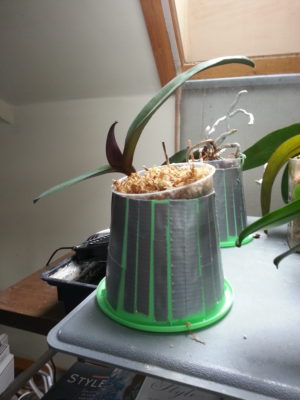Are the leaves of your phalaenopsis drooping? Could sucking insects be feeding on the leaves? Check this by using a jewelers loupe to inspect the top and particularly the underside of the leaves. If you see “critters” then check the American Orchid Society’s advice.
If you are new to growing phalaenopsis orchids, then the most likely cause for drooping is under hydration. Remove the orchid from its pot and inspect its roots. If they are firm, then you likely have been under watering. If they are mushy then you have either been watering your orchid too frequently or you have potted it in too big a container.
Inspect and Possibly Repot
A phalaenopsis with droopy leaves or slow growth prompts me to inspect its roots. I remove mushy ones with a pruner that I have either heated with a flame or on which I have sprayed 91% isopropyl alcohol.
After pruning, I repot the phalaenopsis in a clear plastic pot with ventilation holes along its sides and drainage holes at its bottom. Container size is very important as the plant should cycle through wet and nearly dry phases. By the way, phalaenopsis can grow well though there is little room in the container. Just check out young plants, grown in a nursery, which arrive with their roots well filling their containers but, importantly, the medium includes small pockets of air.
If you decide to repot, the container should be about as wide and deep as the plant’s roots. If the roots are sprawling, I imagine them balled up. If the pot is too deep, I render it functionally smaller by placing pieces of Styrofoam, an inverted plastic cup (requires space but does not store water), or small rocks at its bottom. By the way, rocks enhance the pot’s stability.
I keep my phalaenopsis in either fresh (but not fine) fir bark, sphagnum moss, or a mixture of the two. Importantly, I make sure the juncture of the lowest leaf with the plant’s body is at least 1/4 inch about the surface of the medium. This way, water will not rest between the leaf and the plant’s body if you water carefully!
Stimulating Growth with Heat
The key for promoting growth is heat! I place the pot on a heating pad set to 100 degrees winters and say 85 degrees Fahrenheit summers. I have been using K&H heating pads for dogs, the one’s encased in hard, ABS plastic.
To make sure the roots warm up, I capture the heat rising from the pad by placing the pot in a heat trap. If you don’t do this then the plant does not well warm during winter here in Milwaukee, Wisconsin.

Above you can see a phalaenopsis resting in moss, in a clear plastic pot. (For illustrative purposes, the pot is resting on an angle.) Supporting the pot is an inverted green pot whose bottom was removed and whose holes had been covered with duct tape. This inverted pot is the heat trap. The trap is resting on the gray heating pad.
I have also made heat traps by removing the bottom of plastic containers salvaged from recycling bins. Ideally when inverted the diameter of the trap’s bottom should be greater than the diameter of the orchid pot’s bottom. Also, when inverted the diameter of the trap’s top should be about the diameter of the orchid pot’s top. With these dimensions the trap well captures heat and is removable.
When to Water
Orchids with roots adapted to growing in water or light expanded clay aggregate (LECA) can certainly thrive. That said, I rarely grow orchids in water or LECA. Instead, I use media such as fir bark, sphagnum moss, coco coir, or perlite. With roots adapted to these media, beginners most likely kill their orchids by watering too frequently.
To assess whether my phalaenopsis needs watering, I always keep a wooden skewer poked deep into the center of the medium. From time to time, I withdraw this “dipstick” to assess the moisture level. If the end of the stick is approaching dryness, as revealed by placing the stick’s end on my upper lip, then most likely my phalaenopsis needs water.
Another clue is available if you keep your orchids in clear pots. Inspect the roots. Dry roots are gray; moist roots are green. Of course, visual inspection cannot reveal the moisture level in the pot’s center as does the wooden skewer.
If you are ever in doubt about watering, don’t water! Phalaenopsis kept soaking wet for several weeks (planted in bark, moss, etc.) will likely not recover; their roots will rot! But phalaenopsis not watered for several weeks will recover!
Watering and Fertilizing Your Phalaenopsis
I use two watering containers because I water my orchids twice. Initially, I very thoroughly water the medium with tap or rain water, at room temperature, to wash away salt accumulations.
I am very careful to not water the orchid’s crown to avoid promoting a deadly fungal infection! If water enters the crown I use a napkin to absorb the water or a small fan to evaporate the water.
Immediately after the initial watering, I water again using tap water because it contains beneficial minerals. To the water I have added fertilizer that has been diluted to 1/4 the recommended level.
Which fertilizer to use? They all seem to work, even inexpensive Stern’s Miracle Grow with an analysis whose nitrogen-phosphorus-potassium designation is 24-8-16. Often recommended are fertilizers with balanced designations such as 10-10-10 or 20-20-20.
You can find valuable information about caring for phalaenopsis and other orchid species at the websites of the American Orchid Society and the St. Augustine Orchid Society. Carefully read the advice regarding when to water for over watering or over potting orchids is the most frequent mistake of folks who have just fallen in love with growing orchids!
Please let me know how this works for you.
–Marshall Lev Dermer
Send mail to: marshall@dermer.com
3/29/2024